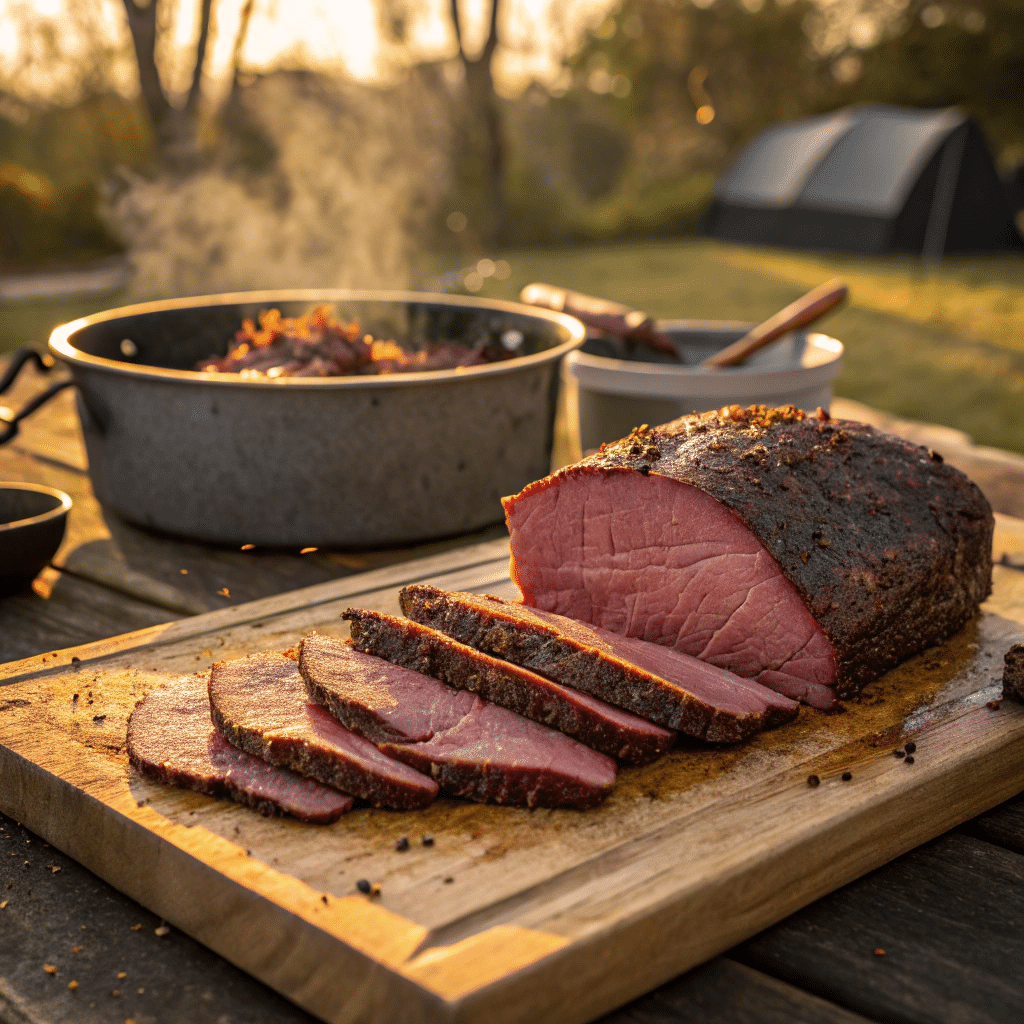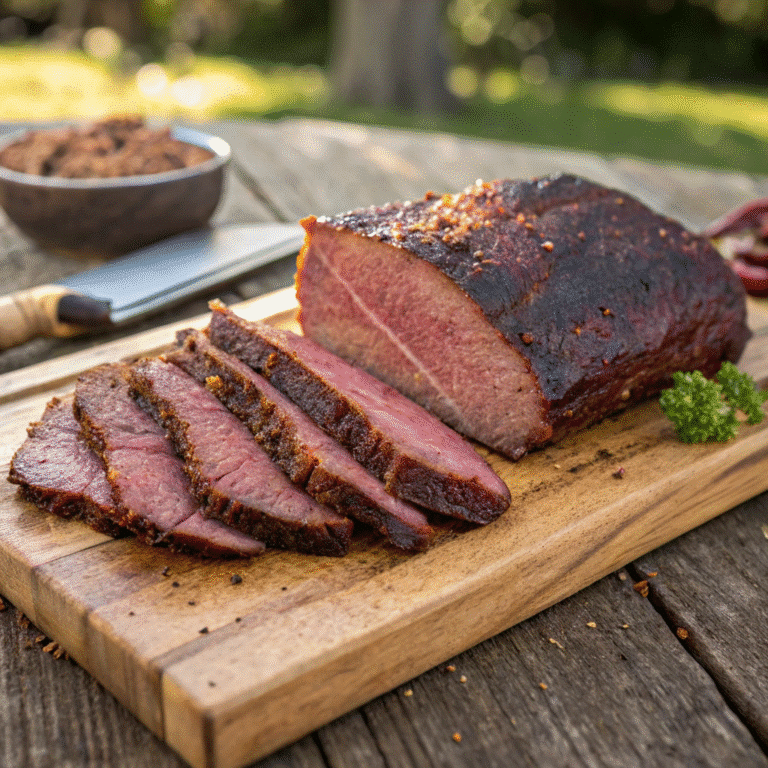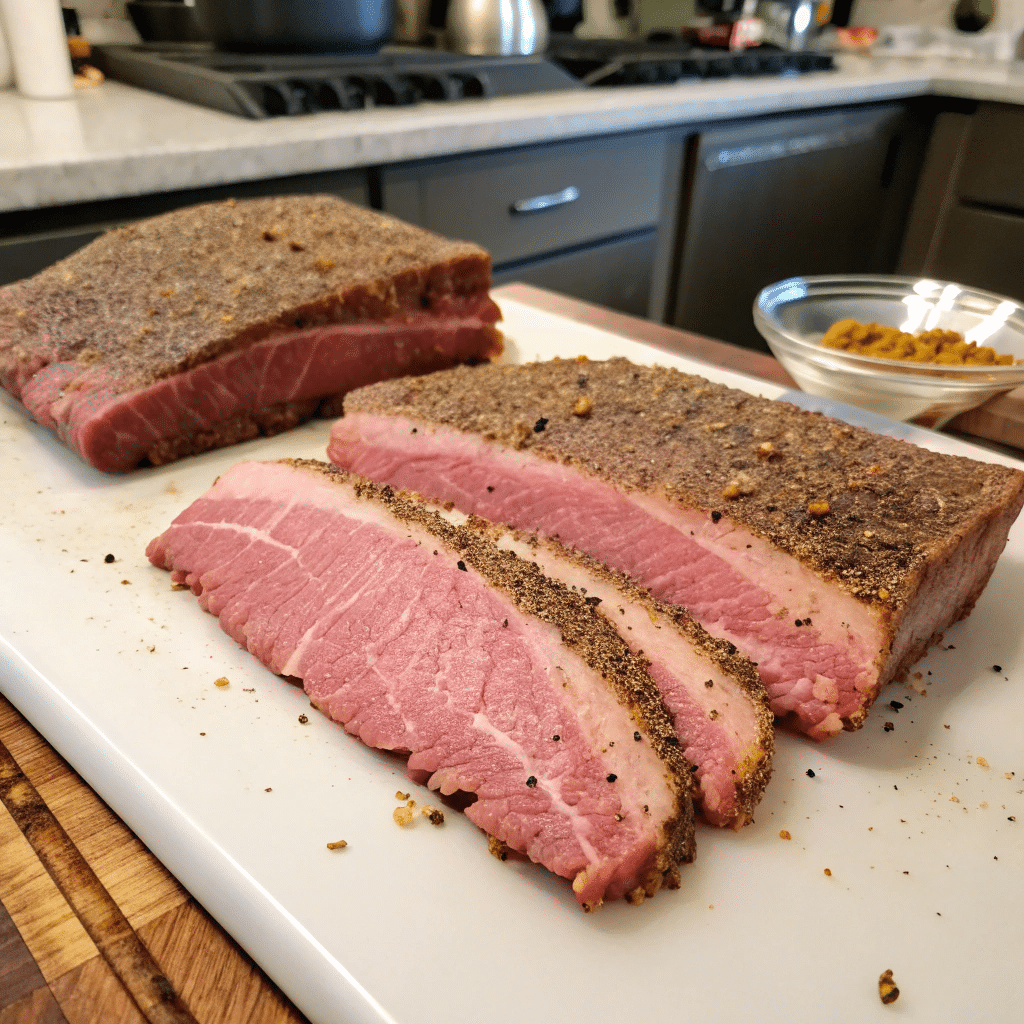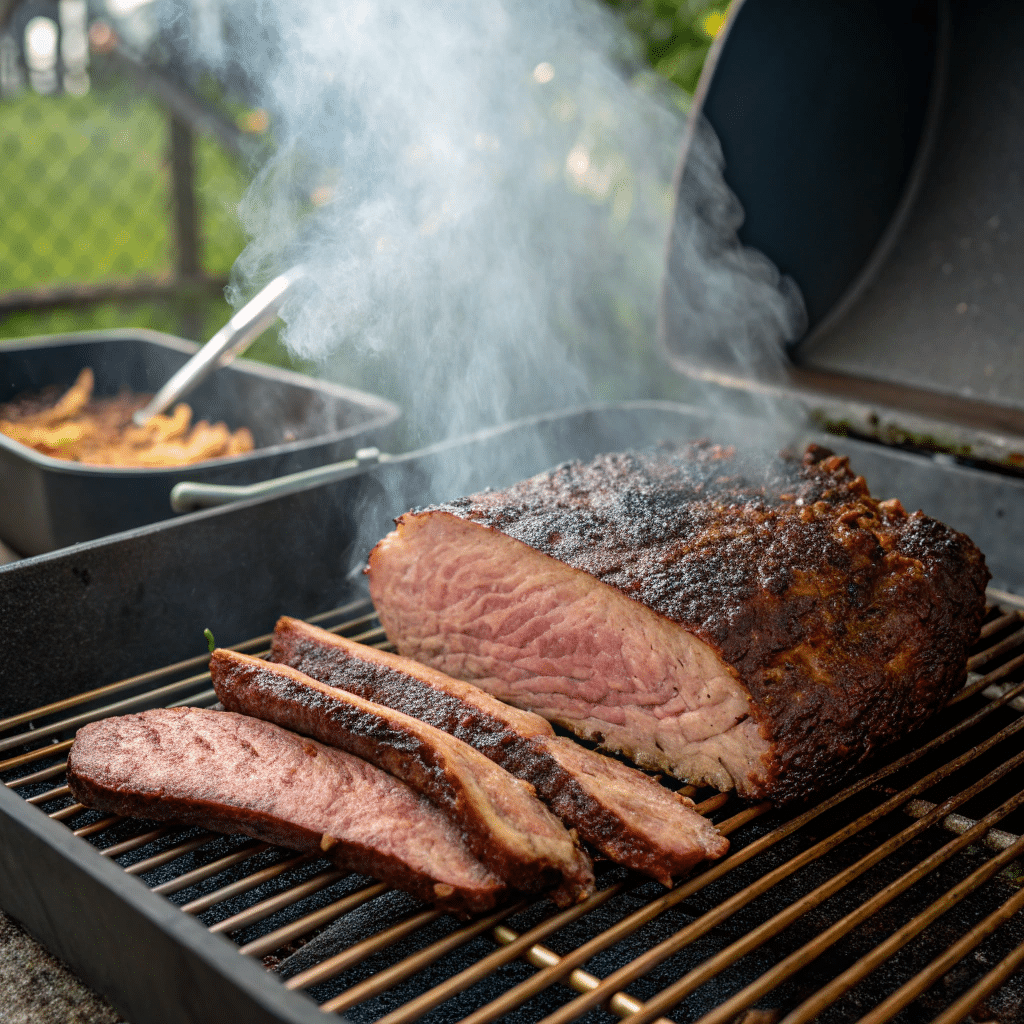If you’re after rich BBQ flavor paired with melt-in-your-mouth tenderness, smoked corned beef is the ultimate dish to perfect. This underrated cut of beef transforms into a savory masterpiece when smoked low and slow, bringing out deep, smoky richness layered with traditional corned beef spices. Whether you’re a seasoned pitmaster or a weekend BBQ warrior, smoking corned beef at home isn’t just satisfying—it’s downright addictive.

This step-by-step guide walks you through the entire process of crafting perfectly smoked corned beef from scratch. We’ll break down how to choose the right beef cut, the brining process, essential smoker settings, and even the best wood for smoking corned beef. We’ll also compare it to pastrami, explore common smoking mistakes, and show you how to serve it like a pro.
Don’t miss our Smoked Mac and Cheese recipe for a creamy, bold side that pairs perfectly with smoked corned beef.
Print
Smoked Corned Beef
This smoked corned beef recipe delivers deep flavor, bold bark, and a juicy interior. Using low-and-slow BBQ technique, it transforms pre-brined brisket into a mouthwatering BBQ centerpiece. Perfect for backyard smokers, holiday meals, or meal prep.
- Total Time: 8 hours 15 minutes
- Yield: 8 servings 1x
Ingredients
1 (3–5 lb) pre-brined corned beef brisket (flat or point cut)
Cold water (for soaking)
Dry Rub:
2 tbsp coarse black pepper
1 tbsp brown sugar
1 tbsp garlic powder
1 tsp ground coriander
1 tsp smoked paprika
1 tsp mustard powder
Instructions
Soak & Rinse: Rinse brisket under cold water. Soak in fresh water for 4–8 hours to remove excess salt.
Dry & Rub: Pat dry. Apply the dry rub generously on all sides. Let rest at room temperature 30 mins.
Preheat Smoker: Set your smoker to 225°F. Use wood chips like hickory or cherry.
Smoke: Place brisket fat-side up on the grate. Smoke for 6–8 hours, until internal temp reaches 195–205°F.
Wrap (Optional): At 165°F, wrap in foil or butcher paper to retain moisture.
Rest: Remove and wrap in towels. Rest 30–60 mins before slicing.
Serve: Slice against the grain and serve with mustard, rye bread, or classic BBQ sides.
Notes
Soaking is key—don’t skip it or meat may turn out too salty.
Use a thermometer to monitor internal temperature, not just time.
For added flavor, spritz with apple cider vinegar or beef broth every hour.
- Prep Time: 15 minutes
- Cook Time: 8 hours
- Category: Main Course
- Method: Smoking
- Cuisine: American / BBQ
- Diet: Gluten Free
Nutrition
- Calories: 340
- Sugar: 1g
- Sodium: 1040mg
- Fat: 24g
- Saturated Fat: 8g
- Protein: 28g
Whether you’re preparing a holiday feast or just want to upgrade your backyard BBQ game, this article will walk you through everything you need to know to create a tender, flavorful smoked corned beef that your family and guests will talk about for weeks.
Table of Contents
Understanding Smoked Corned Beef
What Is Smoked Corned Beef?
At its core, smoked corned beef is a fusion of two classic meat preparation methods: curing and smoking. Corned beef starts as a beef brisket that’s been cured in a seasoned brine, typically with pickling spices, salt, sugar, and curing salt. This curing process transforms the texture and flavor of the beef, giving it that signature pinkish-red hue and a bold, salty punch.
Once cured, the beef is slowly smoked over wood chips—commonly hickory, oak, or cherry—infusing the meat with layers of rich, smoky flavor. The result? A flavorful fusion of classic corned beef and smoky barbecue brisket. Think pastrami, but more rustic and backyard BBQ-inspired.
Unlike store-bought deli slices, homemade smoked corned beef has real bite. The smoke locks in the juices while adding bark (that flavorful crust on the outside), making every slice a flavor bomb. It’s incredibly versatile too—serve it on sandwiches, hash, or even solo with a good mustard dip.
History and Origins of Corned Beef and Smoking Techniques
Corned beef has deep roots in Irish and Jewish-American cooking. The word ‘corned’ comes from the coarse salt crystals—called ‘corns’—used to cure the meat during brining. For centuries, corned beef was a method of preserving meat before refrigeration. It gained popularity in the U.S. as a staple comfort food, especially around St. Patrick’s Day.
Smoking, on the other hand, is even more ancient. Indigenous tribes and early settlers smoked meats for preservation, long before refrigeration was a thing. Over time, smoking evolved into a culinary art, especially in regions like Texas, Tennessee, and the Carolinas.
Combining corned beef with smoking is a relatively modern twist, often linked with BBQ culture and the home-cooking revolution. It’s the perfect blend of preservation, flavor-building, and patience. And with a good smoker, anyone can do it at home—no deli required.
Check out Smoked Deviled Eggs for another bold twist on a classic recipe that complements smoked meats beautifully.
Choosing the Right Cut and Brine
Best Cuts of Beef for Smoking Corned Beef
The success of smoked corned beef depends heavily on selecting the appropriate cut of meat. Brisket is the go-to choice, but it’s important to know it comes in two distinct sections: the point cut and the flat cut.

- Flat cut: With its lean profile and even shape, it’s perfect for neat slices—great for sandwiches or serving on a platter.. It smokes evenly and holds together well.
- Point cut: Rich in marbling and flavor, this cut is juicier and ideal for those who crave tender, pull-apart BBQ beef.
Some markets also sell corned beef that’s already brined. While this can save time, make sure the brine isn’t overly salty or artificial. Reading the label is key—look for cuts with natural seasonings and minimal additives.
The Importance of Brining: Store-Bought vs Homemade
Brining is what gives corned beef its bold, salty flavor. You’ve got two options: store-bought pre-brined beef or homemade brine.
- Store-bought: Convenient, but often packed with sodium and preservatives. Still a good option if you’re short on time—just be sure to rinse it well before smoking.
- Homemade brine: Total control over flavor. Feel free to customize the saltiness and enhance the flavor with fresh aromatics like garlic, peppercorns, bay leaves, mustard seeds, and cloves. A homemade brine also reduces the chances of overly salty or rubbery meat after smoking.
If you’re brining from scratch, plan ahead. Brisket needs to brine for 5–7 days in the fridge for best results.
Looking for inspiration? Try our Smoked Cream Cheese Recipe for a creamy, smoky side that pairs beautifully with corned beef.
Prepping Smoked Corned Beef for Smoking
How to Rinse and Soak Smoked Corned Beef
Before placing your smoked corned beef on the grill, proper prep is critical—especially if you’re working with store-bought corned beef. These cuts often sit in brine for days or even weeks, soaking up loads of salt. Smoking it right away can lead to an overpoweringly salty flavor.
Start with these simple prep steps:
- Rinse your smoked corned beef thoroughly under cold water to remove excess salt and brining spices.
- Submerge it in cold water for 2 to 8 hours, refreshing the water a few times to help draw out extra salt for a milder flavor.
- Dry the meat with paper towels before seasoning.
Skipping this step can throw off the balance of flavors in your final smoked corned beef—especially after a long, slow smoke.
Dry Rubs vs Wet Marinades for Smoked Corned Beef
What makes smoked corned beef special is its ability to soak up rich, bold spices. While it’s already packed with flavor from the brine, adding a rub or marinade introduces that extra punch of BBQ magic.
- Dry Rubs: A dry rub is the go-to choice for most BBQ lovers. A mix of coarse black pepper, brown sugar, coriander, paprika, garlic powder, and mustard powder enhances the natural flavor and helps form that iconic outer bark during smoking.
- Wet Marinades: Some pitmasters go for beer or vinegar-based marinades with Worcestershire sauce and mustard. It adds tang and moisture but may compete with the brined taste of your smoked corned beef.
We recommend using a dry rub if you’re starting with a well-brined cut. It strikes the perfect balance—boosting the BBQ profile while letting the beef shine.
How to Smoke Corned Beef at Home
Step-by-Step Smoking Process
Smoking smoked corned beef at home isn’t hard—it just takes patience and the right steps. Here’s how to get it right:

- Prep the meat: After soaking and drying your corned beef, apply a flavorful dry rub. Let it rest at room temp for about 30 minutes.
- Preheat your smoker: Aim for 225°F (107°C). Cooking at a low and slow temperature is ideal for making the meat tender.
- Position it on the smoker with the fat side facing up to help lock in moisture as it cooks. Use a water pan to keep things juicy.
- Smoke it low and slow for approximately 6 to 8 hours, adjusting based on the size of the cut. A 3–4 lb brisket usually takes 6 hours.
- Internal temp: Your smoked corned beef should hit 190–205°F for full tenderness.
- Let it rest by wrapping in foil or butcher paper for 30 to 60 minutes before slicing to preserve juices and enhance flavor.
The slow smoke breaks down fat and connective tissue, giving your beef that juicy, pull-apart texture BBQ lovers crave.
Best Smoker Settings and Tools to Use
You can smoke corned beef using almost any type of smoker, including:
- Pellet smokers like Traeger or Pit Boss are beginner-friendly, offering a simple set-it-and-forget-it cooking experience.
- Offset smoker: Best for strong smoke flavor, but needs more fire management.
- Electric smoker: Consistent temp, great for smaller batches.
Stick with 225°F–250°F throughout the cook. Use a digital meat thermometer to avoid guessing and always monitor the internal temp.
Check out Smoked Deviled Eggs for a smoky appetizer that complements smoked beef perfectly.
Best Wood for Smoking Corned Beef
Top Wood Chips That Complement Beef Flavor
Choosing the right wood can make or break your smoked corned beef. The wood you use adds depth and character to the meat, balancing the saltiness of the brine with sweet or robust smoky notes.
Here are the best wood options:
| Wood Type | Flavor Profile | Best Use |
|---|---|---|
| Hickory | Strong, bacon-like smoke | Perfect for bold, fatty cuts |
| Oak | Medium smoke, classic BBQ flavor | Great all-purpose choice |
| Cherry | Mild, slightly sweet | Adds color and subtle sweetness |
| Maple | Mild and sweet | Best for balanced flavor |
| Applewood | Light, fruity smoke | Ideal for delicate or smaller briskets |
For optimal flavor, many pitmasters mix hickory and cherry woods—delivering a rich, smoky depth with a hint of sweetness. This blend pairs particularly well with brined meats such as corned beef.
Avoid mesquite unless you’re aiming for an intense smoke profile. It can overpower the natural brine.
How Wood Affects Taste and Texture
The wood you choose doesn’t just impact flavor—it also affects bark development and color. Hardwoods like hickory or oak build a better crust, while fruitwoods like apple or cherry add that beautiful mahogany finish.
If you’re using a pellet smoker, make sure the pellets are 100% natural wood—no fillers or additives. These burn cleaner and give your smoked corned beef a better, more authentic smoke ring.
Smoking Time and Temperature Guide
How Long to Smoke Corned Beef by Weight
Time and temperature are the backbone of great BBQ. When it comes to smoked corned beef, cooking low and slow is key to unlocking tenderness and rich, smoky flavor.
Here’s a basic smoking time guide by weight:
| Weight | Estimated Time at 225°F |
|---|---|
| 2–3 lbs | 4–5 hours |
| 4–5 lbs | 6–7 hours |
| 6–7 lbs | 7–8.5 hours |
General rule: Plan for 1.5–2 hours per pound. Always allow for extra time, especially if you’re smoking during colder weather.
But don’t rely on time alone—internal temperature matters more.
Using a Meat Thermometer for Accuracy
To achieve perfectly tender smoked corned beef, aim for an internal temperature between 195°F and 205°F. At this stage, the collagen and fat have broken down, resulting in juicy, tender slices.
Here’s how to do it right:
- Insert a digital meat thermometer into the thickest section of the brisket to ensure accurate temperature readings.
- When the internal temperature hits 165°F, consider wrapping the brisket in butcher paper or foil to help lock in moisture—this step is optional but beneficial.
- Let it finish smoking until it hits that sweet spot—195°F minimum, 205°F max.
Resting is crucial. After pulling it off the smoker, wrap your beef and let it sit for 30–60 minutes. This lets juices redistribute, ensuring your smoked corned beef slices beautifully without drying out.
Looking for inspiration? Try Smoked Mac and Cheese to serve alongside—it’s the perfect creamy contrast to rich smoked meat.
Smoked Corned Beef vs Pastrami
What’s the Difference?
It’s one of the most asked questions: Is smoked corned beef the same as pastrami? The short answer? Not exactly. While both start with beef brisket and share similar prep methods, the flavor, seasoning, and final results differ quite a bit.
| Aspect | Smoked Corned Beef | Pastrami |
|---|---|---|
| Brining | Salted with pickling spices (pre-brined or homemade) | Same brine as corned beef |
| Seasoning | Often lightly rubbed or unseasoned before smoking | Rubbed heavily with coriander, black pepper, etc. |
| Smoking Process | Smoked low and slow; often unwrapped | Smoked, then steamed to finish |
| Flavor | Salty, smoky, beefy, rustic | Smoky, spicy, peppery, more complex |
| Texture | Firm, juicy with bark | Softer, often more tender due to steaming |
So yes, pastrami is a type of smoked corned beef, but with additional steps—especially the heavy spice rub and a steaming finish. That’s why deli pastrami tastes different from backyard smoked corned beef.
Why the Confusion Between the Two?
Many people confuse the two because they both start with the same brined brisket. But pastrami takes it further with aggressive spice blends and an added steaming step to make it super tender and deli-ready.
In contrast, smoked corned beef leans more into BBQ territory. It’s seasoned to perfection, slow-smoked until tender, then served piping hot with a crunchy bark and a deep, smoky beef punch. Picture it as the bold, rough-around-the-edges relative of the classic pastrami sandwich.
Serving and Storing Smoked Corned Beef
Best Side Dishes and Serving Ideas
Once your smoked corned beef is done and rested, it’s time to enjoy it—and how you serve it can make all the difference.
Here are top serving ideas:
- Sliced and plated: Serve thick, juicy slices with sides like smoked mac and cheese, garlic mashed potatoes, or roasted vegetables.
- Sandwich style: Layer slices on rye or sourdough bread with mustard, Swiss cheese, and pickles.
- Hash: Chop leftovers and pan-fry with potatoes, onions, and bell peppers for a smoky breakfast hash.
- Tacos: Shred and serve in warm tortillas with slaw and BBQ sauce.
Want a creative twist? Pair your beef with smoked deviled eggs or grilled corn for an elevated BBQ platter.
Keep in mind: smoked corned beef pairs well with tangy or creamy sides to balance the salt and smoke.
How to Store and Reheat Smoked Corned Beef
If you’ve got leftovers, don’t worry—smoked corned beef holds up well in the fridge or freezer.
Storing tips:
- Refrigerate: Wrap tightly in foil or an airtight container. Keeps for up to 5 days.
- Freeze: Slice and wrap in freezer paper or vacuum seal. Good for 2–3 months.
Reheating tips:
- Oven: Wrap slices in foil with a splash of broth or water. Reheat at 300°F for 10–15 minutes.
- Skillet: Add a little butter or oil, and heat on medium until warmed through.
- Microwave: Not ideal, but if needed—cover with a damp paper towel and heat in short bursts.
Proper storage ensures your meat stays juicy, smoky, and delicious—even days later.
Common Mistakes to Avoid
Top Smoking Mistakes Beginners Make
Smoking meat sounds simple—low and slow—but when it comes to smoked corned beef, there are a few pitfalls that can ruin the flavor or texture. Here’s what to avoid:
- Skipping the soak can leave your corned beef overwhelmingly salty, throwing off the balance of flavor. Always rinse and soak to balance flavor.
- Too much smoke: It’s tempting to over-smoke, especially with strong woods like mesquite. But smoked corned beef needs a balanced flavor, not a smoke bomb.
- Using high heat: Anything above 250°F can dry out your brisket and ruin the bark. Keep it steady and low—225°F is ideal.
- Not resting the meat: Taking your beef straight from the smoker to the plate means dry slices. Rest it wrapped for 30–60 minutes to lock in juices.
- Skipping the thermometer: Time is just a guide. Always go by internal temp for doneness—shoot for 195°F to 205°F.
One wrong move can turn tender beef into dry disappointment. Avoid these beginner mistakes and your smoked corned beef will come out juicy and flavorful every time.
How to Fix Dry or Tough Smoked Corned Beef
Even the best pitmasters have off days. If your beef ends up too dry or chewy, don’t panic. Here are quick fixes:
- Slice thinner: Thin slices can make tough meat feel more tender.
- Steam it: Wrap in foil with a bit of broth and gently steam in the oven at 275°F for 30 minutes.
- Pair it with a punchy mustard BBQ sauce or a zesty horseradish cream—either one can elevate the whole dish.
Every cook learns through trial and error. The real skill lies in how you recover when plans fall apart.
Looking for inspiration? Try our Smoked Cream Cheese Recipe as a creamy spread for leftover smoked beef sandwiches.
FAQs About Smoked Corned Beef
Is it possible to smoke corned beef without brining it beforehand?
The majority of corned beef briskets found in grocery stores are already pre-brined:Thoroughly wash it to eliminate any leftover brine and spices from the surface.Soak it in cold water (2–8 hours or overnight) to reduce saltinessApply a dry rub after drying it offSmoking pre-brined corned beef straight out of the package without soaking can make it too salty after a long smoke.
Is smoked corned beef the same as pastrami?
Not quite. While both begin with brined brisket, smoked corned beef is typically just gently seasoned and finished in the smoker. Pastrami is coated in a heavy spice rub (mostly black pepper and coriander) and typically steamed after smoking, giving it a softer texture and spicier bite.
What wood is best for smoking corned beef?
Hickory, oak, and cherry are the best woods for smoking corned beef. Hickory gives a bold, smoky punch, oak offers balance, and cherry adds sweetness and color. Steer clear of bold woods like mesquite—they can easily overshadow the meat’s natural flavor.
What’s the smoking time for corned beef?
Smoking time varies by weight, but a good rule is 1.5 to 2 hours per pound at 225°F. A 4–5 pound brisket usually takes around 6–7 hours. Don’t rely just on the clock—when the internal temperature hits between 195°F and 205°F, it’s perfectly cooked.
Follow us on Facebook at how to cooking recipes for daily recipe inspiration and kitchen tips.
